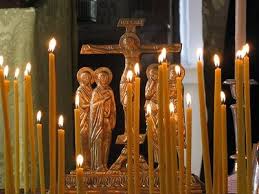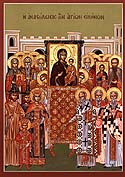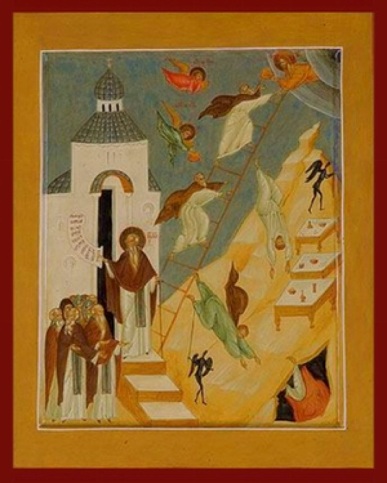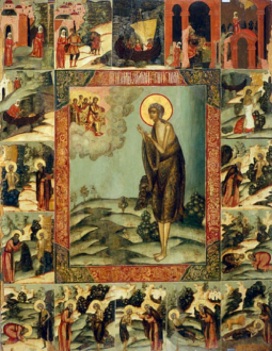The Great and Holy Forty Days (Great Lent)

We begin Great Lent: the Great Fast—the great reflection on life and death. For many weeks the readings of each Sunday have been teaching us how to step back and take a critical look at ourselves. What motivates our actions? (Laws or Love?) How do we see others? (With condemnation or compassion?)
During Lent our task is to focus on our relationship with God. The Fast is not about diet; it is about doing what it takes us personally to bring our consciousness into harmony and awareness of Divine presence in our ordinary existence. Our liturgical services support and sustain our personal journeys by praying together as a community, through the readings, and hymns.
The Forty Days of Great Lent commemorates Israel’s forty years of wandering in the Wilderness the forty years of painful struggle as Israel longed for and then received entrance into the Promised Land (Ex. 16:35) Moses remained fasting on Mt. Sinai for forty days (Ex. 34:28) and the Prophet Elijah fasted for forty days as he journeyed to Mt. Horeb (1 Kings 19:8). Great Lent also recalls the forty days the Lord spent in the Wilderness after His Baptism, when He contended with Satan, the Tempter.
The time of Great Lent encompasses forty days, to which must be added Lazarus Saturday, Palm Sunday and Passion Week. In addition, the Holy Church prescribed three weeks of preparation for the Great Lent itself the Sundays of the Publican and the Pharisee, Prodigal Son, Meatfare and Cheesefare. In all, the Orthodox Church prescribes ten weeks of spiritual and bodily preparation for the joyous Pascha of the Lord.
Our Lenten journey, both personal and communal is encapsulated most perfectly in the Lenten Prayer of St Ephrem. Through this ancient prayer, we recall the lessons of the previous Sundays and with each repetition we take inventory of our status as persons who have professed to “put on Christ”.
 “The greatest poet of the patristic age and, perhaps, the only theologian-poet to rank beside Dante.” (Robert Murray)
“The greatest poet of the patristic age and, perhaps, the only theologian-poet to rank beside Dante.” (Robert Murray)
St Ephrem’s prayer has been said to contain the entire content and purpose of the Great Fast. St Ephrem the Syrian (ca. 306-373 AD) is a Church Father. He was a monk, theologian, and poet, who comforted both bodies and souls during his lifetime. He died ministering to victims of plague and famine in Edessa (SE Turkey today). Traditionally, when we say the words of this prayer, we bring our full body into meditation by making a full prostration (poklin) after each of the three segments, and after repeating the segments together at the end. In between this prayer, it’s customary to repeat (4 times) the prayer of penitence that we pray before receiving the Eucharist: “Lord, be merciful to me a sinner; Lord, cleanse me of my sins and have mercy on me; I have sinned without number, Lord forgive me.” (We bow deeply with each petition and cross ourselves.) English translations of St Ephrem’s prayer vary greatly, but the expression of profound desire to live in Grace is constant nonetheless.
Each year in the Lenten period, we have the opportunity to join 16 centuries of faithful who have been spiritually nourished and encouraged by St Ephrem’s devotion to Christ.
O Lord and Master of my life,
Take away from me the spirit of laziness and indifference, of self-centredness and gossip.
(Prostration)
Grant to me instead the spirit of purity and humility, of patience and of love.
(Prostration)
Yes, O Lord and Master,
Let me recognize my own sins and stop judging others.
For You are blessed, now, always and forever, Amen.
(Prostration)
++++++
Then a simple bow following each verse. The triplet is repeated four times.
O God, be merciful to me, a sinner.
O God, cleanse me of my sins and have mercy on me.
O Lord, forgive me; for I have sinned without number.
The Prayer of St. Ephrem is then repeated, with only one prostration at its conclusion.
Special Lenten Services
Sorokousty
 In our parish, every Wednesday, we pray for the deceased. This service called “Sorokousty,” literally means “forty mouths” referring to an ancient monastic practice of 40 monks or priests singing this commemoration of our departed sisters and brothers. Sorokousty is a beautiful way to remind us that our Christian family reaches beyond our present time and space to encompass generations past. Each family in our parish (including deceased parishioners) have a book where the names of family members who have died are written. Father reads out every name during each Sorokousty.
In our parish, every Wednesday, we pray for the deceased. This service called “Sorokousty,” literally means “forty mouths” referring to an ancient monastic practice of 40 monks or priests singing this commemoration of our departed sisters and brothers. Sorokousty is a beautiful way to remind us that our Christian family reaches beyond our present time and space to encompass generations past. Each family in our parish (including deceased parishioners) have a book where the names of family members who have died are written. Father reads out every name during each Sorokousty.
Liturgy of the Presanctified Gifts
 Because the weekdays during Great Lent are fast days, they are also “aliturgical” which means that traditionally there would not be a Divine Liturgy celebrated on those days. However, in order to supply spiritual support to the faithful, the Church created a special Lenten liturgy: the Liturgy of the Presanctified. This service combines Vespers and the sharing of the eucharist which had been consecrated at the previous Sunday Divine Liturgy.
Because the weekdays during Great Lent are fast days, they are also “aliturgical” which means that traditionally there would not be a Divine Liturgy celebrated on those days. However, in order to supply spiritual support to the faithful, the Church created a special Lenten liturgy: the Liturgy of the Presanctified. This service combines Vespers and the sharing of the eucharist which had been consecrated at the previous Sunday Divine Liturgy.
Sunday of Orthodoxy
 This Sunday marks an important message with which the Church wants us to begin Great Lent: God became human. This might seem strange, but on this Sunday we commemorate the victory of the defenders of icons against those who condemned icons (iconoclasts). The issue was not just icons, but more importantly what does it mean that God became human. Icons are only possible because of the Incarnation of the Son. In taking upon Himself our humanity He demonstrated that we are all called to fulfil our original purpose: to be with God in eternity. This lesson is the culmination of the first week of Lent, when during many of the services we would have heard the opening passages of the book of Genesis: God created the world and it was good and God created humanity in the divine image and likeness. We are called to divinization, according to the ancient holy writers. Now, during Lent, we have the opportunity to engage more earnestly in this calling: to become Christ-like. Opening ourselves to the Holy Spirit, in order to become God’s agents in the world.
This Sunday marks an important message with which the Church wants us to begin Great Lent: God became human. This might seem strange, but on this Sunday we commemorate the victory of the defenders of icons against those who condemned icons (iconoclasts). The issue was not just icons, but more importantly what does it mean that God became human. Icons are only possible because of the Incarnation of the Son. In taking upon Himself our humanity He demonstrated that we are all called to fulfil our original purpose: to be with God in eternity. This lesson is the culmination of the first week of Lent, when during many of the services we would have heard the opening passages of the book of Genesis: God created the world and it was good and God created humanity in the divine image and likeness. We are called to divinization, according to the ancient holy writers. Now, during Lent, we have the opportunity to engage more earnestly in this calling: to become Christ-like. Opening ourselves to the Holy Spirit, in order to become God’s agents in the world.
Why do we celebrate the Sunday of Orthodoxy if we are Catholic?
A very good question. “Orthodoxy” has a number of usages, as does the word “Catholic”. Both these terms can be used in reference to a Christian Church, but that is a very narrow understanding. All major Churches see themselves as orthodox, that is, following the fundamental teaching of the early Christian Church before the various divisions of today arose. The Sunday of Orthodoxy specifically refers to the affirmation of Orthodox Christian teaching on the Incarnation of the Son of God against the teachings of those who opposed the use of icons. This controversy broke out in the 8th and 9th centuries, before the formal division between “Catholics” and “Orthodox” or Western Christianity and Eastern Christianity.
Sunday of St. Gregory Palamas
St. Gregory Palamas was born in 1296 and became a monk on Mount Athos at the age of 20. He became renowned for his devotion to prayer and service to the monastic community. As his holiness became more generally known he became a great defender of solitary or quiet prayer of the heart, known as hesychasm. In 1326 he was ordained a priest and then in 1347 he was ordained Archbishop of Thessalonica. He died in 1359. During the 1340s and 1350s he became the major defender of monastic prayer and the belief that through silent prayer we come to know God, not indirectly, but directly: God truly invites us into a full communion, a full experience of divinity.
Troparion for St. Gregory Palamas – Tone 8
O light of Orthodoxy, teacher of the Church, its confirmation,
O ideal of monks and invincible champion of theologians,
O wonder-working Gregory, glory of Thessalonica and preacher of grace,
always intercede before the Lord that our souls may be saved.
Sunday of the Veneration of the Holy Cross
 This third Sunday of Great Lent “Sunday of the Veneration of the Cross” falls in the middle of Lent for a reason. Why? This period of the Great Fast (Velykyj Pist) calls each of us to focus intensely on reconciliation, critical self-reflection, humility, and our abilities to truly practice Christ-like love and mercy. We are called to fast to help us be more mindful of our actions. If we have been working at this self-consciousness, attending more services, and/or abstaining from food or usual routines, by this time we may well be feeling discouraged. Pascha, like summer at this time of year, may seem just too far away for comfort. For this reason, at church, we remember the Cross of Christ as an inspiration and encouragement to carry on. While the cross itself was an instrument of extreme suffering, cruelty, and death—for us, as Christians, it has become a sign of the opposite reality: victory over death—hope, love, mercy. The Cross is venerated only because of the Resurrection. For us, the Cross is the Tree of Life, because Christ has opened the gates to Heaven. Just as the meaning of the Cross includes renewed life, our own suffering may include joy.
This third Sunday of Great Lent “Sunday of the Veneration of the Cross” falls in the middle of Lent for a reason. Why? This period of the Great Fast (Velykyj Pist) calls each of us to focus intensely on reconciliation, critical self-reflection, humility, and our abilities to truly practice Christ-like love and mercy. We are called to fast to help us be more mindful of our actions. If we have been working at this self-consciousness, attending more services, and/or abstaining from food or usual routines, by this time we may well be feeling discouraged. Pascha, like summer at this time of year, may seem just too far away for comfort. For this reason, at church, we remember the Cross of Christ as an inspiration and encouragement to carry on. While the cross itself was an instrument of extreme suffering, cruelty, and death—for us, as Christians, it has become a sign of the opposite reality: victory over death—hope, love, mercy. The Cross is venerated only because of the Resurrection. For us, the Cross is the Tree of Life, because Christ has opened the gates to Heaven. Just as the meaning of the Cross includes renewed life, our own suffering may include joy.
Kontakion (Tone 7)
Now the flaming sword no longer guards the gates of Eden;
It has mysteriously been quenched by the wood of the Cross!
The sting of death and the victory of hell have been vanquished;
For You, O my Savior, have come and cried to those in hell:
“Enter again into paradise.”
Today, instead of the Trisagion (Sviatyj Bozhe . . .) we sing:
We bow down in worship, to Your Holy Cross, O Master, and we glorify Your Holy Resurrection. (Thrice)
With each repetition, if we are able, we make the sign of the cross and descend onto our hands and knees and bow our forehead to the ground before getting up to a standing position; this is called a prostration. This symbol of humility and worship brings our entire body into prayer. We rise from sinfulness and penance to stand renewed in joy through God’s mercy.
Only on this Sunday and on the Feast of the Exaltation of the Holy Cross (Sept. 14/27), even if it falls on a Sunday, do we do prostrations. Sundays are celebrations of the Resurrection and, even during Great Lent, we are not supposed to kneel during Divine Liturgy. (The 20th canon of the First Ecumenical Council, 325, forbids kneeling on every Sunday and the fifty days between Pascha and Pentecost.)
Sunday of St. John Climacus

The 4 th Sunday of Great Lent is dedicated to St John Climacus, (of the Ladder). This Church Father was a 6 th century Syrian monk whose instructions on how to live a virtuous aesthetic life are written in Ladder of Divine Ascent.
““My God, I pretend to nothing upon this earth, except to be so firmly united to you by prayer that to be separated from you may be impossible; let others desire riches and glory; for my part, I desire but one thing, and that is, to be inseparably united to you, and to place in you alone all my hopes of happiness and repose.” (St John Climacus)

Sunday of St. Mary of Egypt
 As we near the end of Great Lent (Lent itself ends on the following Friday) the Church presents us a most important example of transformation and salvation: St. Mary of Egypt. Mary was born in 344 and at age 12 she ran away from home and entered a life of prostitution and begging. At the age of 29 she decided to journey to Jerusalem. Not, according to her later testimony, because she was going on a pious pilgrimage, but rather because of the possible income she could receive from pilgrims. However, in Jerusalem as she tried to enter the Church of the Holy Sepulchre she felt a strange force holding her back. Recognizing that she was being held back due to her sins, she had a conversion experience, repented of her past life and tried to enter once again. This time she was successful and promised to devote herself to a life of prayer and fasting. Leaving Jerusalem she went to the monaster of St. John the Baptist where she made a public act of repentance and reconciliation, received the Holy Eucharist. The next day she withdrew to the desert to lead the life of a hermit. The only regular contact she had was with St. Zosimas of Palestine who related her life story to St. Sophronius who wrote it down. She received the Eucharist annually on Holy Thursday from St. Zosimas and died on the evening of Holy Thursday in 421. She is one of the most startling examples of conversion and transformation. A reminder that it is never too late for any of us to return to God. A message repeated in St. John Chrysostom’s Easter homily.
As we near the end of Great Lent (Lent itself ends on the following Friday) the Church presents us a most important example of transformation and salvation: St. Mary of Egypt. Mary was born in 344 and at age 12 she ran away from home and entered a life of prostitution and begging. At the age of 29 she decided to journey to Jerusalem. Not, according to her later testimony, because she was going on a pious pilgrimage, but rather because of the possible income she could receive from pilgrims. However, in Jerusalem as she tried to enter the Church of the Holy Sepulchre she felt a strange force holding her back. Recognizing that she was being held back due to her sins, she had a conversion experience, repented of her past life and tried to enter once again. This time she was successful and promised to devote herself to a life of prayer and fasting. Leaving Jerusalem she went to the monaster of St. John the Baptist where she made a public act of repentance and reconciliation, received the Holy Eucharist. The next day she withdrew to the desert to lead the life of a hermit. The only regular contact she had was with St. Zosimas of Palestine who related her life story to St. Sophronius who wrote it down. She received the Eucharist annually on Holy Thursday from St. Zosimas and died on the evening of Holy Thursday in 421. She is one of the most startling examples of conversion and transformation. A reminder that it is never too late for any of us to return to God. A message repeated in St. John Chrysostom’s Easter homily.
